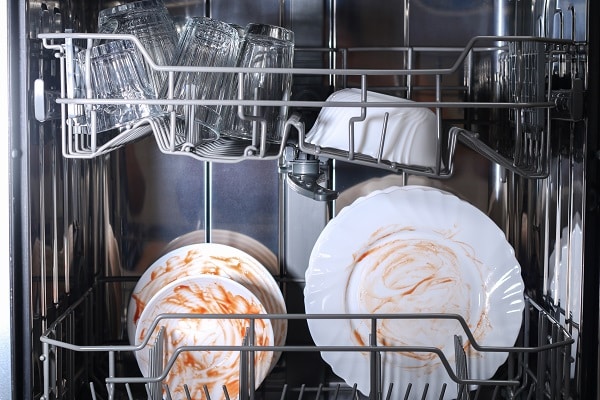
Does your dishwasher no longer clean your dishes as well as it once did? When it begins to malfunction in its main function and you find yourself with a full sink and dishwasher, it can be inconvenient. Are you worrying about your Dishwasher not cleaning? There are a couple fixes you can attempt before you start hand-scrubbing the dishes.
My dishwasher isn’t cleaning; why is that?
You might be lacking an important component if your dishwasher isn’t washing your dishes: water.
Look for Water
Make sure the water valve on your dishwasher is switched on in order to verify that water is flowing. Put the empty cups in the dishwasher after that. Run your dishwasher with one face up on the bottom rack and the other face up on the top rack. If there is water in both cups at the end of the cycle, you can be certain that the water flow is sufficient. Should water flow be present but dishes remain unclean, it might be necessary to modify the water’s temperature.
Change the Temperature
The water won’t be hot enough to dissolve fat and food residue if it is too chilly. Your dishes will therefore be dirtier when they are removed from the dishwasher. However, dish detergent may lose its effectiveness if the water is excessively hot. Your dishwasher should be at least 120 degrees Fahrenheit for optimal performance. A clogged filter may be the cause of your dishwasher’s improper dishwashing if it has water and the right temperature.
Empty the Filter
First, empty the filter and take out the bottom rack in order to clean it. Clear out any material that might be collecting near the dishwasher’s base. Next, find the filter. In most dishwashers, the filter is situated close to the spray arms on the bottom. For precise location information, consult your Owner’s Manual. After removing the filter, give it a water rinse. If food particles have caked on, clean it with a gentle brush. Replacing the filter and bottom rack is necessary after the screen is clean. You can guarantee that your dishes come out spotless by performing routine maintenance like this to maintain the filter in your dishwasher clean.
Make Sure the Spray Arms Are Operating Properly
Blockage or obstruction in the spray arms of a dishwasher is another frequent cause of it not cleaning. Large pots and pans can occasionally keep your spray arms from rotating properly. Turn the spray arms by hand, and make sure nothing is in the way of them. The next step is to look for blockages if there aren’t any visible obstacles. Food particles or oil globules can quickly clog the spray arm’s openings. To simply clear up the holes, use a toothpick.
Examine the dispenser
A soap dispenser that distributes detergent during the wash cycle is a feature of every dishwasher. Your dishes will be cleaned by this detergent, thus it’s critical to make sure the dispenser is operating properly. The dishes might not get clean if the lid stays closed during the cycle. See your Owner’s Manual for instructions, or try opening it manually. If not, consider doing a cycle in the dishwasher without any dishes. There can be an obstruction if the lid still won’t open. If the springs are visible, try cleaning them with a toothbrush or toothpick. They may occasionally become obstructed by food particles and other debris, making it impossible for them to open or close. Alternatively, you can pour vinegar and hot water over the dispenser door. Any residue that might be keeping it stuck will be helped to dissolve and loosen by the vinegar and hot water. On the other hand, the dispenser will require replacement if the door or spring break. If the detergent dispenser isn’t the problem, there might be a problem with the detergent itself.

Use the Appropriate Type and Amount of Detergent
There are few things that can be as annoying as dirty dishes, particularly if you know the dishwasher has been used. It’s critical to use the appropriate kind and quantity of detergent to avoid this problem. Using the incorrect dishwashing soap might result in your dishes being covered in spots because different detergents are designed for different kinds of water. For instance, hard water’s high mineral content can make it difficult for the dishwasher to clean effectively. You must use dishwasher detergent with integrated water softeners if you reside in a hard water location. You have to be careful not to use too much detergent in addition to utilizing the appropriate kind. Excessive sudsing from too much detergent might impede cleaning effectiveness and perhaps harm your dishwasher. Use a rinse-aid solution to make your dishes even more clean.
Rinse-Aid Can Help Avoid Water Spots
Rinse-aids facilitate the easier flow of water over surfaces and the removal of food and soap residue by lowering surface tension in the water. Rinse-aid-washed plates are therefore less likely to get water stains. Therefore, think about adding a rinse-aid to the mix if your dishwasher isn’t cleaning your dishes as clean as you’d want. It can be the key component missing from your flawless dishes.
Load silverware and dishes correctly
Some people think that as long as all of the dirty dishes fit in the dishwasher, it doesn’t matter how you load it. That said, this is untrue. It’s crucial to make sure that every dish is arranged so that the water can reach it because dishwashers are made to shoot water and detergent from the bottom up. If not, you’ll have a dishwasher overflowing with unclean dishes.
Filling the Bottom Rack:
Arrange bigger pots and pans on the exterior and smaller items on the interior of the bottom rack. In order to improve their cleaning, bowls should be inverted to allow water to enter.
Filling the Top Rack:
Arrange little bowls and plates in the center of the upper rack, then place mugs, cups, and wine glasses along the sides.
Not Cleaning Silverware in the Dishwasher?
To guarantee that your dishwasher cleans your cutlery effectively, place knives face down and forks and spoons upright. To prevent silverware from nestling together and obstructing the cleaning action of water and detergent, mix forks and spoons.
Take a few additional minutes the next time you fill your dishwasher to ensure that every dish is positioned correctly. It will have a profound impact on how clean your dishes are. Give Fast Appliances Repair’s dishwasher repair specialists a call right now if your dishwasher is still not cleaning.









